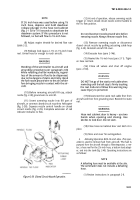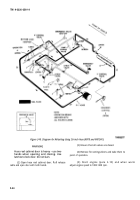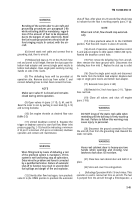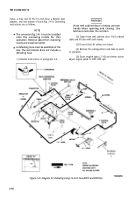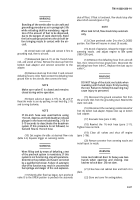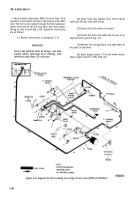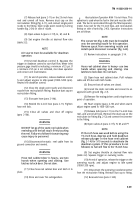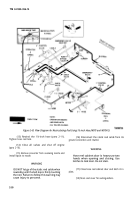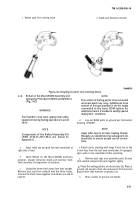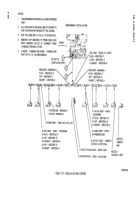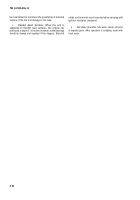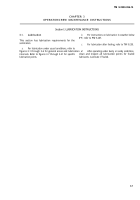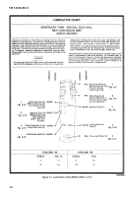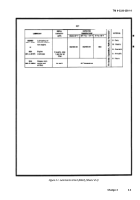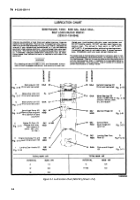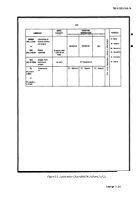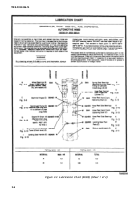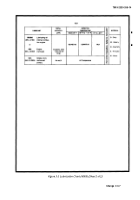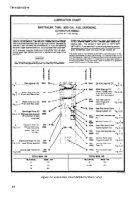TM-9-2330-356-14
SEMITRAILER, TANK: 5000 GALLON, BULK HAUL, SELF LOAD/UNLOAD M967 AND M967A1; SEMITRAILER, TANK: 5000 GALLON, FUEL DISPENSING, AUTOMOTIVE M969 AND M969A1; SEMITRAILER, TANK: 5000 GALLON, FUEL DISPENSING, UNDER/OVERWING AIRCRAFT M970 AND M970A1
TECHNICAL MANUAL; OPERATOR’S, UNIT, DIRECT SUPPORT, AND GENERAL SUPPORT MAINTENANCE MANUAL
OCTOBER 1990
TM-9-2330-356-14 - Page 95 of 528
TM 9-2330-356-14
i.
Obtain the (8) grounding wires from organic
equipment and attach one alligator clamp to ground rod.
Also, ensure that fuel tank semitrailer has been grounded.
j.
Store unused plugs, dust caps, etc., in ROM
accessory container.
k.
Prepare fuel tank semitrailer for filtered fuel bulk
unload (para 2-16).
l.
Start engine and raise speed to proper RPM.
Check ROM system for fuel leaks under pressure.
Correct leaks as necessary.
m.
Refuel convoy vehicles per mission requirements.
Use ground rod wire to ground refueled vehicle.
n.
When deactivating refuel site:
(1) Start engine and put fuel tank semitrailer into
defueling mode. Progressively open nozzles beginning
with those farthest from tanker using a drip container to
catch any spillage.
(2) Disassemble all components after draining
fuel back into tanker.
(3) Stop engine. Replace vehicle hoses and dust
caps. Put dust caps and plugs on all ROM components and
stow in ROM accessory container. Refer to storage
diagram on container.
Section III. OPERATION UNDER UNUSUAL CONDITIONS
2-20. General
a.
You must follow the approved practices and
precautions. A detailed study of FM 21-305 and FM 55-30
is essential for use of this material under unusual
conditions.
b.
For description of operations in extreme cold,
refer to FM 9-207.
c.
Under sandy, dusty, mud, water, or salt water
operating conditions, inspect, clean, and lubricate parts
frequently.
2-21.
Extreme Cold Weather Operation
a .
Drain Water.
During cold weather operations, the
accumulated water in the semitrailer fueling system may
freeze. It is important to drain the water from the entire
system after each operation to prevent damage to the
fueling system components (para 2-13
d
). Remove drain
plug from engine fuel tank and drain any accumulated
water from tank.
WARNING
A warm air blower maybe used to preheat the
brake shoes. Make sure the heater itself is at
least 50-ft from semitrailer to prevent fuel
vapor from semitrailer entering blower
heating chamber.
Failure to follow this
warning may result in serious injury or death
to personnel.
b.
Frozen Parts.
The driver must be alert to frozen
systems while pulling the semitrailer after shutdown.
Congealed lubricants may cause failure of parts. Tires
frozen to the ground, or frozen to the shape of the flat spot
while under-inflated must be considered. One or more
brake shoes may be frozen fast and may require
preheating to avoid damage to the internal parts and brake
drums.
c.
Driving.
Refer to FM 21-305 for special
instructions on driving hazards in snow, ice, and unusual
terrain encountered under extreme cold weather
conditions.
d.
Engine Operation.
Refer to paragraph 2-10 for
operating instructions of the engine in extreme cold
weather.
2-22. Extreme Hot Weather Operation
a.
Parking.
When practical, park the semitrailer
under cover to protect it from sun, sand, and dust.
b.
Engine Operation.
Refer to paragraph 2-10 for
engine operating instructions in extremely hot weather.
c.
Effects of Humidify.
Vehicles parked for long
periods in hot, humid weather are subject to rapid rusting
and accumulation of fungus growth. Inspect often, clean,
and lubricate to prevent deterioration.
2-23. Operation on Unusual Terrain
a.
Sand.
Inspection, cleaning, and lubrication of
working parts must be made often when operating under
extremely dusty or sandy conditions. Wheel bearings
should be cleaned and repacked with lubricants as
specified on the lubrication order after operation under
extremely dusty or sandy conditions.
b.
Rocky Terrain.
Use extreme caution when
traveling over rocky terrain. Specified tire inflation should
2-53
Back to Top

